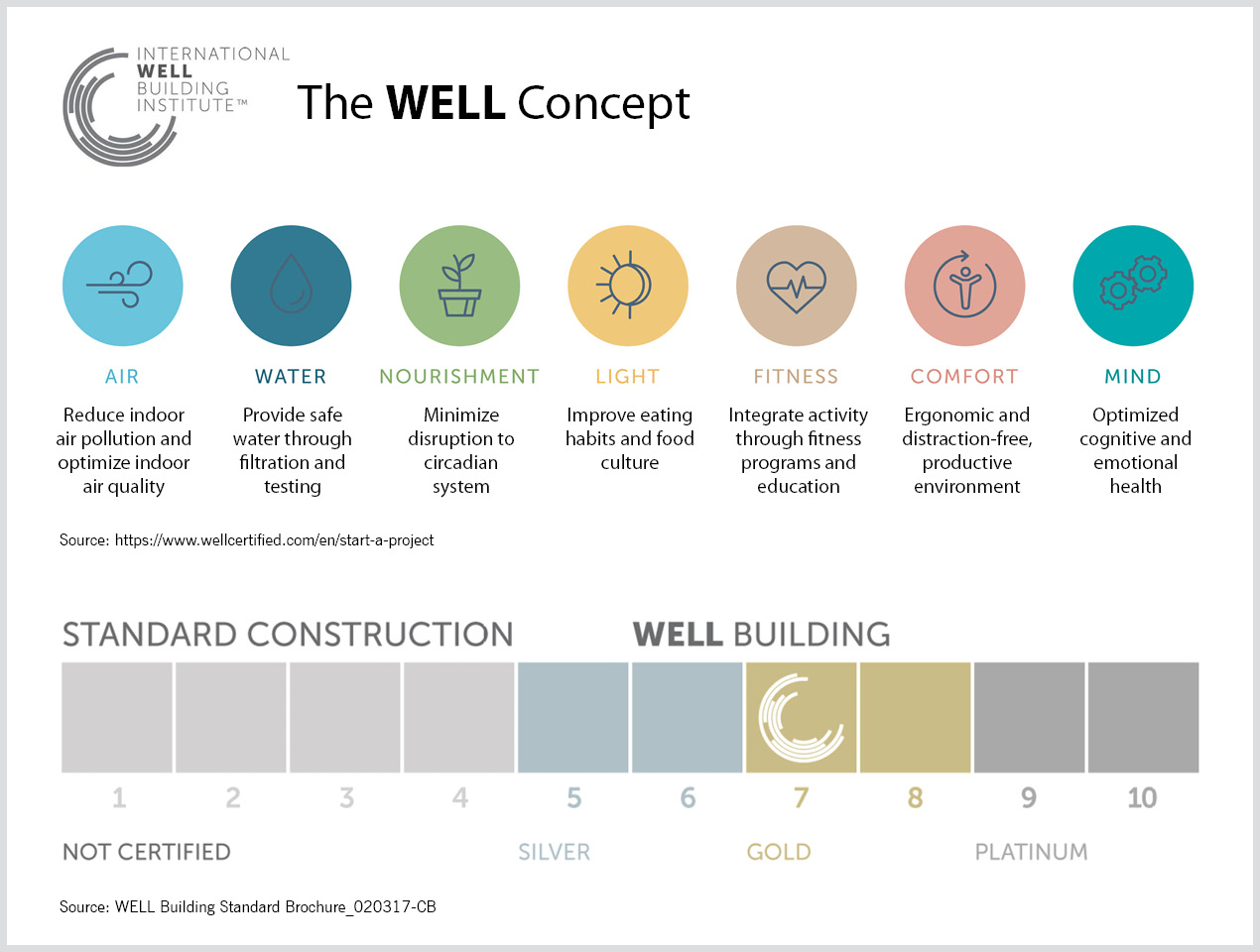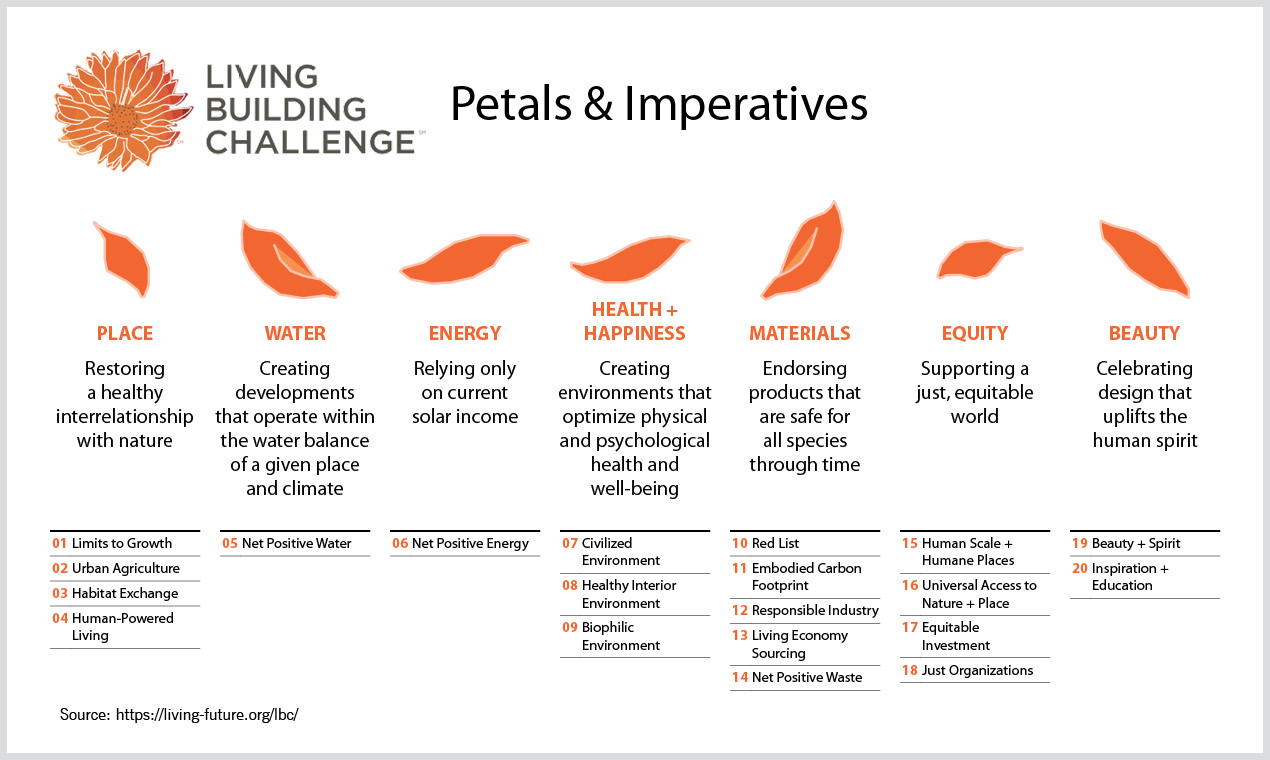Construction, maintenance and the day-to-day use of buildings are one of the most important factors that affect greenhouse emissions. Sustainable design seeks to reduce negative impacts of the built environment on the natural environment and support the health and comfort of building occupants1.
How can we know if a particular building is achieving these objectives?
Various sustainability rating systems exist to answer that question. They provide industry benchmarks that quantify methods and goals for achieving sustainability in the built environment. Though they all focus on the overall goal of sustainability, they tackle the issues differently. Some are building centric with a focus on the construction and energy usage of buildings, while others focus on the users. Therefore, it is important for developers and building owners to approach sustainability and select corresponding ratings systems according to the needs of their project and the intended end users.
As with most certifications, however, there is a cost associated with designing for sustainability and evaluating the results.
What is the benefit for incurring the additional costs—both design and material costs and documentation costs?
As our collective awareness of our impact upon the environment has increased, market demand for sustainable design has also increased, and rating systems offer a standardized metric for comparing sustainable projects. Therefore, it can serve as a differentiator for developers and builders by helping to market a unique quality of the project with the anticipated client base or jurisdictions. Some jurisdictions may also require a minimum sustainability certification, in which case achieving a higher level of certification can set the project apart from the rest.
Additionally, though the upfront costs of design and construction can be higher, long-term operational and maintenance costs are often lower for a sustainably designed building. These benefits have been reported by various groups and agencies including the General Services Administration (GSA) and other government agencies who own a large and varied amount of real estate and building projects2. The U.S. Green Building Council (USGBC) has also reported that LEED-certified buildings have a 20 percent reduction in maintenance costs and 17 percent higher occupancy rates versus traditional construction3. These tangible, long-term benefits will be experienced by the building owners and can support a price premium for developers that plan to sell or lease the building.
How do you begin to evaluate a sustainable metric system for your project?
As the sustainable market and rating systems become more advanced and specialized according to project type, project goals, and users, it is important to select the appropriate metric system for each project. Additionally, because all rating systems have minimum thresholds to meet, it is important to check if the project is eligible for a particular rating system before selecting it. Some of the information to gather before making this decision includes the project location, the project type and size, the project budget, a list of existing jurisdictional requirements, and restrictions or limitations. You may need to gather additional information as you evaluate which metric would best apply, but the list above is a good start. Then it is important to have an overview of the different options.
Here is an overview of three of the most recognized sustainability rating systems:
(1) LEED (Leadership in Energy & Environmental Design)
What is LEED: It is a voluntary, consensus driven, internationally recognized green building certification system. As one of the longest standing rating systems, it is the most common with widespread market recognition. The primary focus of LEED standards is on energy usage and reducing the carbon footprint through efficient building design. Because of its applicability to multiple project types, it is highly flexible. It evaluates strategies aimed at improving performance across metrics such as: energy savings, water efficiency, CO2 emissions reduction, improved indoor environmental quality, and resource stewardship4.
Applicable Project Types: Building design and construction, including new construction, core and shell, schools, retail, hospitality, data centers, warehouses and distribution centers, and healthcare. Interior design and construction, including commercial, retail and hospitality interiors.
Metrics: The LEED rating system issues certification in four levels: Certified, Silver, Gold, and Platinum, which allows for balancing cost implications, goals, and market differentiation. Mandatory prerequisite strategies vary by project category. For new construction and significant renovation projects they include construction pollution prevention, minimum water use reduction, building commissioning, minimum energy optimization, and air quality requirements among others. Additionally, there are credit or impact categories, which include integrative process (IP), location and transportation (LT), sustainable sites (SS), water efficiency (WE), energy and atmosphere (EA), materials and resources (MR), indoor environmental quality (EQ), innovation (IN), and regional priority (RP). Applicants can choose which credits they would like to document and submit for evaluation. Each credit earns a varied number of points based on the project's performance and these points add up to provide the project with its certification level5.

(2) WELL
What is WELL: It is one of the newer, more specialized rating systems utilizing scientific and medical research on the connection between buildings and health and well-being. It focuses on the people in the building by exploring how to optimize design, operations, and behaviors within the places where we live, work, and learn to advance human health and well-being. With a primary focus on the interior environment of buildings, it is especially suitable for office and institutional buildings. It goes beyond energy usage to address concerns such as availability of healthy food options and support of mental health. Therefore, it is imperative to understand that unlike LEED, adoption of WELL is a user-driven metric that requires an adoption of the values by the end user6.
Applicable Project Types: Commercial and institutional buildings, including new and existing buildings, core and shell, and new and existing interiors. Additionally, a pilot program exists that looks at multifamily residential, education facilities, retail, restaurants, and commercial kitchens.
Metrics: Preconditions are the core of the WELL building standard and projects are required to achieve the minimum level of certification. Optimizations are not required to achieve Silver, but offer a pathway to achieve Gold or Platinum. Both preconditions and optimizations address specific aspects of building occupant health, comfort, or knowledge. The preconditions are prerequisite requirements to meeting the optimizations within a category. These categories include air, water, nourishment, light, fitness, comfort, and mind7.

(3) LIVING BUILDING CHALLENGE
What is Living Building Challenge: The Living Building Challenge (LBC) is the certification process developed by the Living Building Institute (LBI), which has created a framework for projects to work towards the ideal built environment. The certification program, LBC, encourages designers, builders, and owners to work together to have their buildings function "as cleanly and efficiently as a flower."8
The Living Building Institute believes that buildings should be:9
• Self-sufficient - remaining within the resource limits of their site.
• Regenerative - connecting occupants to light, air, food, nature, and community.
• Positive - creating a positive impact on the human and natural systems that interact with them rather than merely minimizing negative impacts.
Applicable Project Types: Minor renovations (<75%), major renovations (>75%), new construction, and landscape and infrastructure (non-conditioned development), such as open-air, parklike structures, restrooms, amphitheaters, roads, bridges, plazas, sports facilities, or trails (LBC 3.1 Standard).
Metrics: The program consists of 20 imperatives, which are grouped by category under seven petals. There are three different paths to certification available:10
• Living Building Certification requires the imperatives assigned to a typology as well as 12 months of occupancy data.
• Petal Certification requires at least three of the seven petals be accomplished, one of which must be either water, energy, or materials. Additionally, imperatives 01- Limits to Growth and 20 - Inspiration + Education, must be accomplished.
• Zero Energy Certification requires projects to generate all energy on site without combustion.

Which sustainability metric system is the right one for your project?
While each of these sustainability rating systems differ in their approach, they do share the fundamental goal of reducing the impact of our built environment. There are overlaps between the rating systems on certain categories that allows a project undergoing a certification under one rating system to qualify possibly for points under a different rating system as well.
LEED is the most commonly used metric as well as the most flexible. When incorporated from the beginning, design and construction decisions can be made to accomplish LEED certification. As many projects have been LEED certified, there are many precedents for understanding each credit and its requirements.
WELL relies heavily on the practices of the end user like offering healthy food choices and using green cleaning products. It is most applicable to projects that involve the end user in the design and construction process. For example, office spaces have seen a significant benefit from WELL certification11. The process of receiving a WELL certification is long because it requires a one-year post-occupancy analysis and certification is only received after this has occurred; therefore, it is important to consider the timeline when pursuing this certification.
LBC has the strictest requirements and is best suited for building owners who are determined to make a positive impact. LBC projects are most successful when the entire design team, including contractors, are involved in the design process. Many LBC projects are projects constructed by building owners who retain possession of their projects after construction completion12.
Each metric has different benefits depending on the project. Regardless of which metric you choose, you know that you are contributing to the health and longevity of the built environment.








